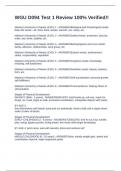WGU D094 Test 1 Review 100% Verified!!
Maslow's Hierarchy of Needs LEVEL 1 - ANSWERSBiological and Physiological needs:
basic life needs - air, food, drink, shelter, warmth, sex, sleep, etc.
Maslow's Hierarchy of Needs LEVEL 2 - ANSWERSSafety Needs: protection, security,
order, law, limits, stability, etc.
Maslow's Hierarchy of Needs LEVEL 3 - ANSWERSBelongingness and Love needs:
family, affection, relationships, work group, etc.
Maslow's Hierarchy of Needs LEVEL 4 - ANSWERSEsteem needs: achievement,
status, responsibility, reputation
Maslow's Hierarchy of Needs LEVEL 5 - ANSWERSCognitive needs: knowledge,
meaning, self-awareness
Maslow's Hierarchy of Needs LEVEL 6 - ANSWERSAesthetic needs: beauty, balance,
form, etc.
Maslow's Hierarchy of Needs LEVEL 7 - ANSWERSSelf-actualization: personal growth,
self-fulfillment
Maslow's Hierarchy of Needs LEVEL 8 - ANSWERSTranscendence: helping others to
self-actualize
Stages of Physical Development
INFANCY (Birth - 2 years) - ANSWERSINFANTS: hold heads up, roll over, reach for
things, sit, crawl, begin to walk, increased coordination, manipulate objects with hands
BY AGE 2:
feed themselves with hands, jump and run awkwardly, throw a ball, pull a zipper down,
make a tower of blocks
Stages of Physical Development
EARLY CHILDHOOD (2 - 6 years) - ANSWERSTODDLERS: love to run, hop, tumble,
play, swing, jigsaw puzzles, string beads, fine motor skills begin developing
BY AGE 4: print name, eats with utensils, dress and undress self
Stages of Physical Development
MIDDLE CHILDHOOD (6 - 10 years) - ANSWERSslow, steady weight gain, speed and
coordination improve, begin organized sports
,BY AGE 10: improved writing skills, engages in organized sports
Stages of Physical Development
ADOLESCENCE (10 - 18 years) - ANSWERSweight and heigh increase, girls typically
begin puberty before boys
BY LATE ADOLESCENCE:
boys are typically taller and more muscular than girls of the same age, girls' physical
growth slows, boys may grow into early adulthood
Piaget's Stages of Cognitive Development
STAGE 1 - ANSWERSSENSIORIMOTOR
- Birth to 2 years
- Babies = 5 senses and gross motor skills. Objective permeance by the end of the
stage
Piaget's Stages of Cognitive Development
STAGE 2 - ANSWERSPREOPERATIONAL
- 2 to 7 years
- Pre = Preschoolers = illogical, egocentric
Piaget's Stages of Cognitive Development
STAGE 3 - ANSWERSCONCRETE OPERATIONAL
- 7 to 11 years
- Grade Schoolers = Factual. They like concrete hands-on activities
Piaget's Stages of Cognitive Development
STAGE 4 - ANSWERSFORMAL OPERATIONAL
- 11 years and older
- Think abstractly and use hypotheses
The Basic Principles of Piaget's Theory - ANSWERS- Assimilation: New information
comes in and it is the same/similar to previous information. You just add to your
scheme. The s in assimilation stands for the same.
- Accommodation: New information comes in and is different than previous schemes.
You have to change your scheme. The c in accommodation stands for change.
MKO (Vygotsky) - ANSWERSMore Knowledgeable Other (MKO) - According to
Vygotsky we learn through socialization with a More Knowledgeable Other (an adult,
older child, or more knowledgeable peer).
Zone of Proximal Development (Vygotsky) - ANSWERSZone of Proximal Development
- The just right place to teach a child. Not too hard, not too easy. They need a little
support (scaffolding) from the teacher. Think of first and second grade reading groups -
these groups are placing the students in their zone of proximal development.
, Erickson's Stages of Psychosocial Development
INDUSTRY VS. INFERIORITY - ANSWERS(6 - 12 years - grade schoolers) At this
stage we want to provide positive reinforcement to students. Focus on their strengths.
Help everyone to be successful.
Erickson's Stages of Psychosocial Development
IDENTITY VS. ROLE CONFUSION - ANSWERS(12 - 18 years -middle and high
schoolers) The adolescents is trying to figure out what they want to do with their lives.
Erickson's Stages of Psychosocial Development
INTIMACY VS. ISOLATION - ANSWERS(20s through early 40s)- Finding a partner and
friends. Having people, you can count on and not feeling alone.
Bandura's Theory of Observational and Modeling Learning - ANSWERS- Social
Learning = Social Cognitivism
- Modeling and Emulation - "Bobo Doll Experiment" - "Monkey see, Monkey do" - You
watch someone model a behavior and then try and emulate (copy) it.
Bandura's Theory of Observational and Modeling Learning
3 TYPES OF MODELS - ANSWERS3 Kinds of Models
1. live - demonstrates behavior in person
2. verbal - explain or describe behavior
3. symbolic - books, movies, tv, video games, etc.
Bandura's Theory of Observational and Modeling Learning
FOR LEARNING TO BE SUCCESSFUL - ANSWERSFor Learning (emulation) to be
successful:
1. Attention- Focus, pay attention
2. Retention - Remember it
3. Reproduction - Be able to perform it
4. Motivation - Want to copy the model
Kohlberg's Theory of Moral Development
PRECONVENTIONAL - ANSWERSPreconventional- When you follow rule because
there is either a punishment or reward (Instrumental Relativist). Take the PRE in
Preconventional. The P stands for punishment and the re stands for reward.
Stage 1: Punishment-obedience orientation
Stage 2: Instrumental orientation
Kohlberg's Theory of Moral Development
CONVENTIONAL - ANSWERSWhen you follow the rules because that is the rule or
because you do not want to be judged poorly. Picture someone wearing an "I Love
Rules" shirt. "I love the rules" "I am such a good person"
Stage 3: Good boy-nice girl orientation
Stage 4: Law-and-order orientation




